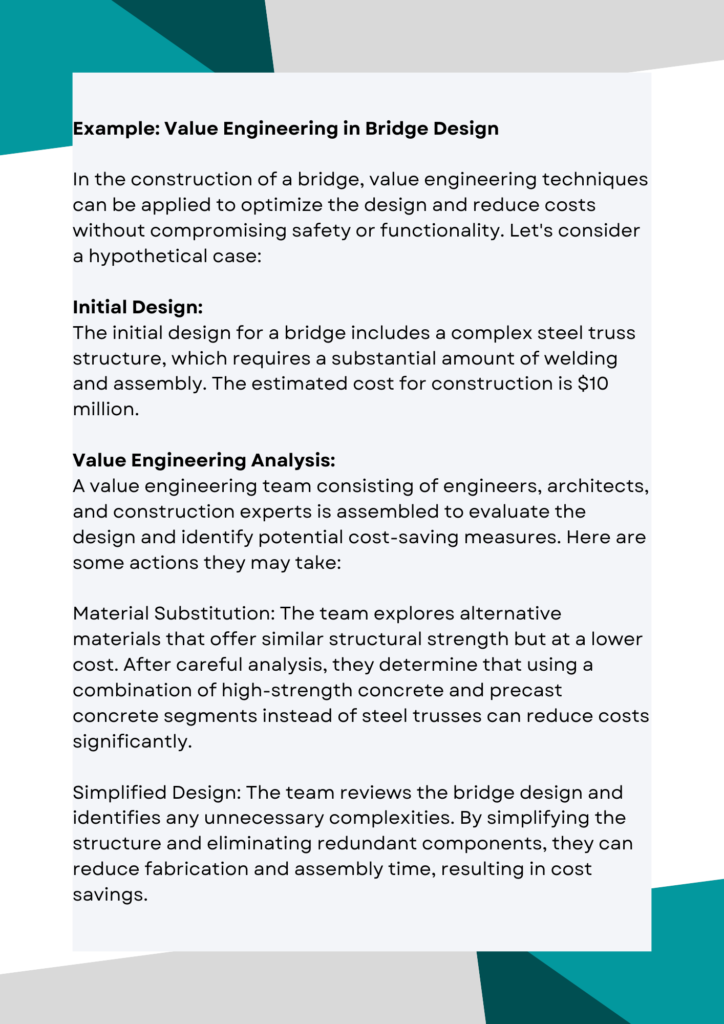Value engineering is a systematic approach to improving the value of a product, system, or service by identifying and eliminating unnecessary costs without sacrificing functionality.
Value engineering can be applied to a wide range of projects, from new product development to facility renovations. It can be used to reduce costs, improve quality, or shorten delivery times.
How to Apply Value Engineering
The process typically follows these steps:
- Define the project scope and objectives: This step involves gathering relevant information about the product or process under review
- Identify the essential functions of the product or service: The project is then carefully analyzed to identify areas where improvements can be made
- Brainstorm alternative methods and materials: A team of experts, including engineers, designers, and other stakeholders, come together to brainstorm and generate ideas for enhancing value.
- Evaluate the alternatives and select the most cost-effective solution: The generated ideas are evaluated based on criteria such as cost, performance, feasibility, and potential benefits
- Implement the solution and monitor the results: The selected ideas are implemented through design changes, process improvements, or other appropriate action
- Monitoring and review: This allows for continuous improvement and refinement of the product or process
It is a team-based process that involves identifying the essential functions of a product or service, evaluating alternative methods and materials, and selecting the most cost-effective solution.
Benefits of VA
Value engineering encourages using alternative methods and materials that are less expensive and do not lower the functionality of the system, service, or product.
- Reduced Cost
- Improved quality
- Shorter delivery times
- Increased Customer services
How it all started!
The concept of value engineering started in the 1940s at General Electric Co. This was during the Second World War when there was a shortage of raw materials, component parts, and skilled labour.
Value Engineering vs. Value Analysis
While VE is typically employed before a product is manufactured, VA is used to evaluate an existing product. Frequently, the objective of value analysis is to evaluate an existing set of costs and benefits with the aim of enhancing its value.
Value engineering occurs beforehand to prevent value loss, whereas value analysis occurs post-factum and can be used to correct product defects. Value engineering is typically utilised in the manufacturing sector, whereas value analysis may be utilised more frequently in the business or sales division.
| Feature | Value Engineering | Value Analysis |
|---|---|---|
| Purpose | To identify and eliminate unnecessary costs before a product or service is developed | To identify and eliminate unnecessary costs after a product or service has been developed |
| Timing | Conducted during the design phase | Conducted after the product or service has been developed |
| Focus | On preventing value loss | On remediating value loss |
| Team | Cross-functional team | Team of engineers and designers |
| Process | More structured and formal | Less structured and formal |
| Benefits | Can save money, improve quality, and shorten delivery times | Can save money and improve quality |
Example of Value Engineering
A customer may ask the manufacturer to construct the joint between two system components. The initial design may amount to a bolt-on solution accomplished by extending mating flanges to the existing components to attach the parts.
Engineers could run this step through a VE analysis before launch to consider redesigning a more integrated joint, using less material, and potentially recommending a different manufacturing technique to incorporate joints into a single component.
Construction Industry
- Replacing costly construction materials with more cost-effective alternatives without compromising structural integrity.
- Streamlining building layouts to maximize space utilization and reduce construction costs.
- Optimizing HVAC (heating, ventilation, and air conditioning) systems to improve energy efficiency and reduce operational expenses.
Manufacturing Industry
- Redesigning product components to simplify manufacturing processes and reduce production costs.
- Evaluating and selecting alternative raw materials or suppliers to lower material costs without sacrificing quality.
- Standardizing manufacturing processes to enhance productivity, eliminate waste, and improve quality control.
Software Development
- Identifying and removing unnecessary features or functionalities that do not add significant value to the software product.
- Optimizing code structure and algorithms to improve performance and reduce resource requirements.
- Utilizing open-source or existing software components instead of developing custom solutions to reduce development time and costs.
Transportation and Logistic
- Analyzing and optimizing supply chain networks to minimize transportation costs and improve delivery efficiency.
- Reducing packaging material and optimizing packaging design to decrease shipping costs and minimize waste.
- Implementing route optimization algorithms to enhance fuel efficiency and reduce transportation expenses.
In summary, It involves analyzing and identifying opportunities for cost reduction, performance improvement, and overall optimization while maintaining or enhancing the desired functionality and quality.
VA/VE is not just about cost reduction. Engineers can improve a product’s function or quality profile or enhance profitability to uncover funding for capital or other investment projects. Whether the team is analyzing an initial design to optimize the year-one profitability or collaborating on a production part, it is essential to engage the team efficiently to empower them to generate high-quality ideas quickly.
Further Reading
Value Engineering – Overview, History, Steps, and Examples (corporatefinanceinstitute.com)
Thanks to Bard and ChatGPT





